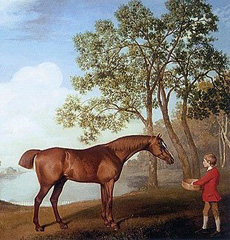AQUILA

...if I have always worked honestly, my horse will carry me to the end of the world. E.F. Seidler |
News - Dutch Campeonate PRE 2008, Deurne |
|
| Back to Current News | |
|
The PVN (PRE Vereniging Nederland), the Dutch PRE association, held its 2008 championship on the weekend of the 5th & 6th of July at the Hippisch Centrum Deurne, near the Dutch-German border. Being in the area, I decided to head over for the weekend to have a look.
As this was an official competition it was run in accordance with ANCCE regulations, and with Spanish judge Sr. Javier Bayo Sánchez. Mares, fillies and colts were evaluated on their morphology and movement, and stallions were evaluated on morphology, movement and functionality. The morphology section was run first. In this section, the horses were asked to walk down the centreline of the arena, past the judge (standing at 'B'). After the horse moved past the judge, the judge would move to the centreline and watch the horse walk away from him. When the horse reached the end of the arena it was asked to canter on the longe, returning to the trot - at which point the handler would attempt to convince the horse to exit the circle at a trot, and trot actively up the long side of the arena (with the handler still at longe-rein distance). On reaching the far end of the arena, the goal was to continue trotting a semi-circle, and then continue back to the centre of the arena, where the judge was waiting. At 'X', the horses were stood up for inspection. The functionality section was held on Sunday. In this section, riders were asked to perform a basic work out demonstrating: walk, halt, working trot, extended trot, walk on the loose rein, working and extended canter on both reins. Twenty metre circles were ridden at the trot and canter, and simple changes seemed to be acceptable (i.e. transition from walk to canter through trot). This was a very interesting section to watch: some owners had organised professional riders, some owners were themselves advanced dressage riders (with their horses trained to upper level), and some owners were just normal pleasure riders - although the standard of horsemanship appeared to be very high. This difference in training levels and riding ability must make judging very difficult - whilst the riders were not being judged, the professional riders often seemed able to show their horses to better advantage. For the stallions, the morphology and movement sections account for around fifty percent of the total points, which meant that the rankings from day one could change dramatically on day two. This didn't happen – the leaders from the morphology and movement sections were also at the top of the functionality section. Several championships were awarded for movement, young horse, functionality and (most anticipated) the breed champions and reserves (male and female). The stallion that took the highest honours on the day was Spanish bred stallion Huerfano X, bred by Nueva Creacion, presented by C. Blanco, the german-based daughter of the breeder. I believe that this horse received total points of 79.23. This horse was quite a 'modern' Spanish horse, not so much in the 'Baroque' style. The reserve champion was the tall, very Spanish, Marismeno XLV. This horse, bred in Spain by Nicolas Osuna Garcia, is competing Prix St. George with owner and rider A. Brenninkmeijer. I am not sure what points this horse received. The third horse under consideration for the breed champion was Gringo WH, bred in the Netherlands by Poppel vW, owned by German stud Caballos de la luz and presented and ridden by well known German B. Rassche (who presented horses for various owners during the weekend). This Carthusian line horse (if the green and white brow-band and rosettes can be trusted), received half a point less than Huerfano X - which tends to indicate that not much separated the top horses. The lovely mare Principia was awarded champion of movement, with 8.333 points for movement, and 79.091 points in total. There were approximately 60 horses competing over the weekend, several crossing the border to compete. The Germans possibly made themselves unpopular as German-based or German-owned horses took out the breed and functionality champions. Apparently there are around 400 PREs in the Netherlands at the moment, many of which have been imported from Spain. Horses bred in Belgium, France and Germany were also represented. I was told that it costs approximately 600 Euro to ship a horse up from Spain, and that it is not uncommon for breeders to ship their mares down to Spain to be covered during the breeding season. This makes it relatively easy for European breeders to expand their blood-lines. The people that I met were lovely and welcoming; by chance I sat next to a Spanish breeder on Saturday morning, who offered opinions and insight into the horses and what was being looked for. Many of the Dutch audience were happy to translate comments to English, and one lovely lady spent twenty odd minutes translating a seminar on the in-hand training of young horses. This helpfulness meant that I gained a lot more from the weekend than I may have otherwise. Additional photos can be seen at www.wolffphotography.nl. Full results from the championship can be viewed here. |
|
 |
|
Horse trucks |
Yearling fillies |
 |
 |
3yo fillies - Hayana (champion) |
3yo fillies - Ibera WH (best movement) |
 |
 |
3yo colts - Valiente (champion) |
3yo colts - Hercules XLV (best movement) |
 |
|
Judges booth and expo area |
|
. |
|
. |
|
| A short clip of the start of a dressage demonstration by Marismeno XLV, competing at Prix St. George: | |
. |
|
An in-hand demonstration by Principia: |
|
. |
|